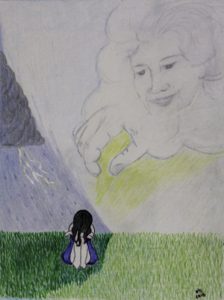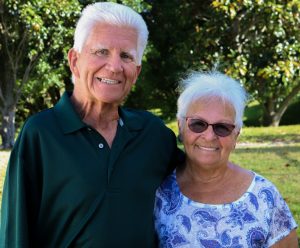‘Coffee and Cedar: Finding Strength from Memories’ Review
With Father’s Day upon us, it’s the perfect time and opportunity to reflect on the men in our lives who have profoundly affected the individuals we are today — fathers, sons, brothers and, last but not least, grandfathers. For one young man, his grandfather played a pivotal role in modeling him into the person he is today. “Coffee and Cedar: Finding Strength from Memories” by D.H. Cermeño takes the reader on an illustrated journey through the meaningful relationship between that young man, David, and his grandfather, Atun.
The Powerful Aroma of Coffee and Cedar
 Memories come in all forms, shapes and sizes. For some, a photo can trigger a heartfelt memory of a day spent on the beach with family and friends celebrating the Fourth of July. For others, a song heard during a television commercial can transport a person back to dancing cheek to cheek with a first love at the high school prom. But sometimes, there is nothing stronger to recall a fond memory than a scent associated with a loved one. A memory taken out of the bank and used in times of need to assist in navigating over life’s hurdles.
Memories come in all forms, shapes and sizes. For some, a photo can trigger a heartfelt memory of a day spent on the beach with family and friends celebrating the Fourth of July. For others, a song heard during a television commercial can transport a person back to dancing cheek to cheek with a first love at the high school prom. But sometimes, there is nothing stronger to recall a fond memory than a scent associated with a loved one. A memory taken out of the bank and used in times of need to assist in navigating over life’s hurdles.
“Coffee and Cedar” is a story depicting the relationship between the author and the grandfather who raised him. David lost his parents at a young age, and Atun filled the heart-wrenching gap as best he could. For anyone outside looking in, Atun raised David as if he was his own son. His grandfather made sure David attended school, prayed in church and nursed him back to health if the need arose.
Before he retired, Atun worked as a chef. Believe it or not, the favorite part of his day wasn’t the meals he cooked but indulging in a cup of freshly brewed coffee. The scent of the coffee triggered memories for Atun of his childhood and the strong bond he had with his father. It was back in the day when technology did not impact day-to-day life and father and son were able to have meaningful conversations.
Similarly, David remembered the aroma of his grandfather’s coffee, but added to his memory bank for future reflection was the strong scent of cedar. As a boy, David’s favorite place to hide during hide-and-seek was Atun’s closet, which was filled with blocks of cedar to ward off pesky moths.
Motivational Empowerment
Besides the sharing of how powerfully scented memories can uplift spirits, “Coffee and Cedar” delves into motivational empowerment. Throughout the book, there are multiple instances when David needs encouragement as naysayers get the best of him. ‘El sol no se tapa con un dedo,” which translates to, “You cannot cover the sun with a single finger.” The saying boils down to the fact that no one can take away any talent within a person – a talent is like the sun, larger than a mere finger.
This Atunism is the empowering statement running throughout “Coffee and Cedar.” It demonstrates the importance and value of believing in yourself despite any adversity you might face.
“Nurture your talents. When you have a gift that no one can take away, don’t let anyone or anything negative make your doubt your abilities,” said the author’s grandfather nightly at bedtime. This empowering statement was a philosophy passed down from generation to generation.
Award-winning Story
Despite its brevity, the book packs a strong punch. The messages woven throughout “Coffee and Cedar” are meaningful and impactful for children and adults alike. It is easy to see why “Coffee and Cedar” is an award-winning story. To date, the book has won the following:
- President’s Book Awards Winner from the Florida Authors & Publishers Association
- Beverly Hills Book Awards Finalist
- Winner in the “Death and Dying” category in the 2019 Body Mind and Spirit Book Awards
At Chapters Health System, every day is devoted to educating our patients and keeping them in the place they call home. We are dedicated to ensuring that patients, young and old alike, and their families are able to make educated decisions about important healthcare matters. For more information, please call our helpful Chapters Health team at 1.866.204.8611 or send an email to info@chaptershealth.org.
 About Phoebe Ochman
About Phoebe Ochman
Phoebe Ochman, Director of Corporate Communications for Chapters Health System, manages all content and communications for the not-for-profit organization.
Age-Appropriate Books to Help Children Understand Death and Grief
There are many books that explain death and grief in terms that are age appropriate for children. The following books are just a few that can be useful resources when discussing these topics with kids, primarily for those under the age of 10:
The Goodbye Book (child 3+)
I’ll Always Love You (child 3+)
The Memory Box (child 4+)
Wherever You Are My Love Will Find You (child 4+)
Sun Kisses, Moon Hugs (child 5+)
Pax (children 8-12)
The Thing about Jellyfish (children 9-14)

 That led to the picture with the words “one year later” on it.
That led to the picture with the words “one year later” on it.



 About Stewart W. Stein, MD
About Stewart W. Stein, MD Interactions between mother and daughter change as each adapts to what they both know the future holds in store for them. Thandi yearns for her mother’s touch but is at a loss, and she watches her parent retreat into herself. “She would hug me or touch my cheek, and I would look deep into her eyes, searching for something that had already gone.”
Interactions between mother and daughter change as each adapts to what they both know the future holds in store for them. Thandi yearns for her mother’s touch but is at a loss, and she watches her parent retreat into herself. “She would hug me or touch my cheek, and I would look deep into her eyes, searching for something that had already gone.”

 For the most part, Eleanor remained healthy until she became a centenarian and the side effects of the aging process caught up with her.
For the most part, Eleanor remained healthy until she became a centenarian and the side effects of the aging process caught up with her. Myth #2: Older women don’t need Pap smears.
Myth #2: Older women don’t need Pap smears. Military veterans are important threads in the fabric of this country. They should always be honored and revered for their patriotic service to the United States. One such veteran acknowledged by many local and even national organizations for his bravery and valor was Elmer Vincent Sublett. Enlisting in the U.S. Armed Forces in 1940, Elmer served during World War II as a member of an elite buffalo solider fighting group.
Military veterans are important threads in the fabric of this country. They should always be honored and revered for their patriotic service to the United States. One such veteran acknowledged by many local and even national organizations for his bravery and valor was Elmer Vincent Sublett. Enlisting in the U.S. Armed Forces in 1940, Elmer served during World War II as a member of an elite buffalo solider fighting group.
 Ninety-eight-year old Elmer was honored with a military honor pinning in his home in Valrico, which was performed by LifePath Hospice Spiritual Care Coordinator Bruce Souder. Shortly after this ceremony, Elmer’s daughter invited Bruce to attend another celebration service that featured a special presentation from Tampa Mayor Bob Buckhorn as well as one from the Tampa Bay area Buffalo Soldiers motorcycle riding group.
Ninety-eight-year old Elmer was honored with a military honor pinning in his home in Valrico, which was performed by LifePath Hospice Spiritual Care Coordinator Bruce Souder. Shortly after this ceremony, Elmer’s daughter invited Bruce to attend another celebration service that featured a special presentation from Tampa Mayor Bob Buckhorn as well as one from the Tampa Bay area Buffalo Soldiers motorcycle riding group.
 If the family lost a parent, try making something special with the kids. Give them choices and get them involved. Children are flexible and can adapt to change, sometimes more readily than adults.
If the family lost a parent, try making something special with the kids. Give them choices and get them involved. Children are flexible and can adapt to change, sometimes more readily than adults. No matter what came to mind when closing your eyes and thinking about the holidays, most of us will agree one of the best things about the holidays is spending time with loved ones. Even if you need to travel long distances by car, train or plane to be with them, it is well worth the time and effort. Unfortunately, the enjoyable can sometimes be accompanied by the stress of holiday travel. Never fear as we have some holiday travel tips so you can take advantage of every precious moment with as little aggravation as possible.
No matter what came to mind when closing your eyes and thinking about the holidays, most of us will agree one of the best things about the holidays is spending time with loved ones. Even if you need to travel long distances by car, train or plane to be with them, it is well worth the time and effort. Unfortunately, the enjoyable can sometimes be accompanied by the stress of holiday travel. Never fear as we have some holiday travel tips so you can take advantage of every precious moment with as little aggravation as possible.
 Not sure where to begin? There are many
Not sure where to begin? There are many  Cover hair tools. Even though your holiday travel destination — whether house or hotel — might very well have a hairdryer or other styling tool, you might still decide to bring your own from home. Add to the mix using said tool right before you head out the door and the dilemma about what to do about your hot hair styling tool. There’s a simple solution: Cover the hot tool with an oven mitt, which will prevent other items in your suitcase from getting scorched as well as keep everything clean.
Cover hair tools. Even though your holiday travel destination — whether house or hotel — might very well have a hairdryer or other styling tool, you might still decide to bring your own from home. Add to the mix using said tool right before you head out the door and the dilemma about what to do about your hot hair styling tool. There’s a simple solution: Cover the hot tool with an oven mitt, which will prevent other items in your suitcase from getting scorched as well as keep everything clean.